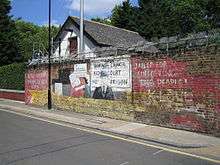Poplar Rates Rebellion
The Poplar Rates Rebellion, or Poplar Rates Revolt was a tax protest that took place in Poplar, London, England, in 1921. It was led by George Lansbury, the previous year's Labour Mayor of Poplar, with the support of the Poplar Borough Council, most of whom were industrial workers. The protest defied government, the courts, and the Labour Party leadership. George Lansbury would later go on to be the leader of the Labour Party.
Background
Poplar (now in the London Borough of Tower Hamlets) was one of the poorest districts of London; there was no government support to alleviate the high unemployment, hunger, and poverty in the borough, which had to be funded by the borough itself under the poor law. Poplar's Labour administration elected in 1919 undertook a comprehensive programme of social reform and poor relief, including equal pay for women and a minimum wage for Council workers, far in excess of the market rate. This programme was expensive and had to be funded from the rates.
Because Poplar was a poor borough, property rents were low. With liability for local taxation assessed on the basis of a 'rateable value' deriving from rents, Poplar had to set a much higher rate in order to produce the same amount as produced by low rates in a wealthy borough. In addition Poplar ratepayers were charged a precept to pay for the London County Council, Metropolitan Police, Metropolitan Asylums Board and the Metropolitan Water Board. There was a small fund which attempted to correct for the different rate products but Poplar called for complete equalisation of the rates so that the same rate brought in the same income both to Poplar and to a wealthier West London borough.
History
In 1921, faced with the prospect of a further large increase in the rates, Poplar Council decided to hold them down by not collecting the precepts which it should have passed on to the four cross-London authorities. The London County Council and Metropolitan Asylum Board responded by taking the matter to the High Court. The council's response was to organise a procession of 2,000 supporters from Bow, led by the borough's official mace-bearer, to the accompaniment of a band and a banner proclaiming, "Poplar Borough Council marching to the High Court and possibly to prison". Thirty councillors, including six women, one of whom, Nellie Cressall, was pregnant, were sent to prison indefinitely for contempt of court for refusing a court order to remit the monies. The men were put up in Brixton Prison, and the women in Holloway (where they were much better treated than the men).[1] The latter were taken by cab to Brixton where council meetings were held. Susan Lawrence used the time to read Tolstoy and prepare a pamphlet on taxation.[2]
Outcome
The revolt received wide public support. Lansbury addressed crowds that regularly gathered outside, through the prison bars. Neighbouring councils threatened to take similar action. Trade unions passed resolutions of support and collected funds for the councillors' families. Eventually, after six weeks' imprisonment, the court responded to public opinion and ordered the councillors released, which occasioned great celebrations in Poplar. Meanwhile, a bill, the Local Authorities (Financial Provisions) Act 1921, was rushed through Parliament more or less equalising tax burdens between rich and poor boroughs.
Despite the equalisation of rates, the dispute regarding the moneys paid for outdoor relief would continue for some years until the abolition of the Poor Law Unions, and therefore Poplar's requirement to provide outdoor relief, under the Local Government Act 1929.
The term "Poplarism", always identified closely with Lansbury, became a political term associated with large-scale municipal relief for the poor and needy, and also came to be applied generally to campaigns where local government stood against central government on behalf of the poor and least privileged of society.[3]
The Hale Street Mural

A mural commemorating the rebellion was painted in 1990 by local resident Mark Francis, drawing a parallel with the contemporary campaign against the Community Charge ('Poll Tax'). In the early 2010s, the mural underwent restoration.
The London Mural Preservation Society has a webpage on the mural.
References
Sources
1. Noreen Branson, "Poplarism, 1919–1925: George Lansbury and the councillors' revolt", Lawrence and Wishart, 1979.
2. Janine Booth, "Guilty and Proud of it – Poplar's Rebel Councillors and Guardians 1919–1925", Merlin Press, 2009 (http://www.merlinpress.co.uk/acatalog/GUILTY_AND_PROUD_OF_IT_.html).
3. Shepherd, John (January 2011). "Lansbury, George". Oxford Dictionary of National Biography Online edition. Retrieved 2 February 2013. (subscription required)